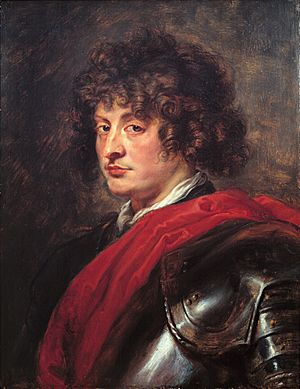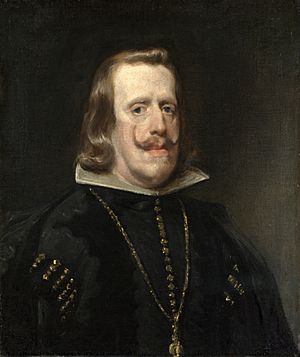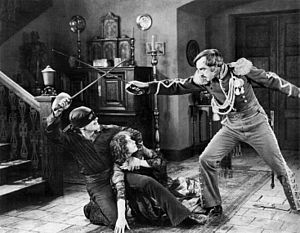William Lamport facts for kids
Quick facts for kids
William Lamport
|
|
|---|---|

Young man in armor, by Peter Paul Rubens, is reputedly of Lamport
|
|
| Nickname(s) | Guillén Lombardo |
| Born | 1611-1615 Wexford, Ireland |
| Died | 1659 Mexico City, Mexico |
William Lamport (or Lampart) (born between 1611 and 1615 – died 1659) was an Irish adventurer. He was a Catholic and became known in Mexico as "Don Guillén de Lamport (or Lombardo) y Guzmán". He was put on trial by the Mexican Inquisition for trying to start a rebellion. He was executed in 1659.
Lamport claimed he was the secret son of King Philip III of Spain. This would have made him the half-brother of King Philip IV. In 1642, he tried to lead a rebellion against Spanish rule. He wanted to unite Black people, Indigenous people, and local merchants. However, someone he tried to recruit told on him. He was arrested and spent 17 years in an Inquisition prison. Today, a statue of Lamport stands inside the Angel of Independence monument in Mexico City.
Contents
William Lamport's Early Life
Childhood and Schooling
Most of what we know about William Lamport comes from his own statements. He gave these statements to the Inquisition. It is hard to know how much of it is completely true. William Lamport was born in Wexford, Ireland. This was either in 1611 or 1615. His family were Catholic merchants.
Lamport received a very good education. He learned about many different subjects. He started his studies in his hometown of Wexford with private teachers. Later, he studied with Jesuits in Dublin and London. He also attended an Irish college in Santiago de Compostela, Spain. By the time he finished school, he knew Spanish, Latin, and Greek.
At this time, the Protestant rulers in England limited opportunities for Catholics. So, many colleges for Irish students were set up in Spain. Catholic Ireland and Spain had strong, long-standing connections. Spain saw Irish nobles as equals to Spaniards. Irish people could even become Spanish citizens.
In 1627, Lamport said he was arrested in London. He was accused of trying to cause trouble. He had been giving out Catholic pamphlets. He claimed he escaped and left Britain for Spain. He then became a pirate for two years. He also said he fought for the French army. This was during the Siege of La Rochelle against the Huguenots.
Military Career
In Spain, Lamport caught the eye of the Marquis of Mancera. This might have been through Mancera's sister. Her late husband had been in London and knew Lamport's teacher. In 1633, Lamport joined an Irish army group supported by Spain. He fought against Swedish forces in the Spanish Netherlands.
His actions in the Battle of Nordlingen in 1634 were noticed. This caught the attention of the Count-Duke of Olivares. Olivares was the main advisor to King Philip IV of Spain. Olivares helped Lamport join the King's service. By then, Lamport had changed his name to Guillén Lombardo. In Mexico today, he is usually called Guillén de Lampart. Lamport gained special benefits by working for the King. After many years, he became a respected veteran of the Spanish crown in 1640.
Life at the Spanish Court
Lamport wrote a flattering report about Olivares, the King's advisor. He then joined the court as a writer who promoted the King's ideas. In the 1630s, he had a relationship with a young woman. Lamport later left Spain for New Spain (Mexico). He sailed on the same ship as the new viceroy, the Marquis of Villena. Also on board was Don Juan de Palafox y Mendoza. Palafox was the new bishop of Puebla. He was also in charge of reviewing the old viceroy's time in office. Palafox and the new viceroy quickly disagreed.
The problems at court might have made Lamport leave. Lamport said he was sent to New Spain to gather information. He claimed he was a spy for the crown. He was to check if the old viceroy's reports about unhappy local people were true. Then he was to report on the new viceroy, Villena. He did send a report to Olivares that was negative about Villena. But his personal papers also showed drafts that supported Villena.
Arrest and Time in Prison
Political events in Spain were very important. In 1640, there was a big revolt in Catalonia. This rebellion was eventually stopped. But Portugal successfully broke away from Spanish rule. They had been ruled by Spain for 60 years. John, Duke of Braganza became the new king of Portugal.
The situation in Mexico became tense. The new viceroy, Villena, was related to the new Portuguese king. Around 1641, Lamport started planning a rebellion. He wanted to overthrow the viceroy. He tried to convince Indigenous people, Black people, and Creole merchants to join him. He told his plans to a Captain Méndez. Instead of joining, Méndez reported him to the Inquisition. Méndez's statements to the court said Lamport claimed ties to the Spanish royal family. However, Lamport's own statements did not say this.
It is not clear why the Inquisition tried Lamport. His alleged crimes usually did not fall under their power. Lamport was in prison for eight years. But he escaped for one day on Christmas Eve 1650. He escaped with his cellmate, Diego Pinto Bravo. No guards were on duty that night. They removed the bars of their cell and got out.
Instead of running to safety, Lamport tried to give a letter to the viceroy. When that failed, he put up posters in the capital city. These posters accused the Inquisition of wrongdoing. The Spanish crown then printed and gave out 200 pamphlets. These pamphlets spoke badly about Lamport. This suggests that Lamport's escape might have been expected. It might even have been helped. The escape then gave a reason to charge him with more serious crimes.
For 60 years, Spain and Portugal had the same king. Many Portuguese merchants did business in the Spanish Empire. Some of them were crypto-Jews. This meant they pretended to be Christians but practiced Judaism. They lived in Mexico City and Lima. When Portugal became independent, these merchants were seen as suspicious. The Mexican Inquisition started investigating them closely. This led to many trials. A huge public punishment, called an auto-da-fé, happened in Mexico City in 1649. Many people were accused and punished. But William Lamport was not part of this event. Perhaps there was not enough strong evidence against him at that time.
While in prison, Lamport had access to paper and pens. He wrote religious poems in Latin. Some of Lamport's original writings are now available online.
Execution
In 1659, after 17 years in the Inquisition jail, William Lamport was found guilty. The Mexican Inquisition said he was a heretic. They sentenced him to be burned at the stake. A record of the auto-da-fé is in the diary of Gregorio Martín de Guijo. It clearly mentions Don Guillén de Lombardo in the procession of those found guilty.
William Lamport's Political Ideas
Don Guillén was a very educated man. He had been close to powerful people in Spain. We don't know exactly why he started planning a rebellion in New Spain in 1641. But the papers found when he was arrested show his ideas. These papers included a declaration of independence. They also spelled out his political thoughts and plans.
A key idea for him was that the Spanish crown had no right to rule New Spain. He agreed with 16th-century thinkers like Bartolomé de las Casas. Lamport proposed that New Spain should be independent. It would have a king with limited powers. This king would be chosen by the people who supported the rebellion.
Don Guillén's writings show he knew many people in New Spain were unhappy with Spanish rule. He knew that the viceroy Cadereyta had told the crown about unhappy Creoles. Bishop Don Juan de Palafox y Mendoza, who sailed with him to New Spain, sided with the Creoles. It is not surprising that Don Guillén first mentioned American-born Spaniards (Creoles) as being mistreated.
From the mid-1500s, the crown had reduced the special rights of Spanish conquerors. They limited the encomienda system. This system gave Spaniards control over native towns' labor and tribute. The crown also started favoring Spaniards born in Spain for important jobs. Viceroys were almost always born in Spain. Their loyalty to the Spanish crown was seen as absolute.
The appointment of Cadereyte, a Creole born in Peru, was unusual. His replacement, viceroy Villena, was a problem. Villena was related to João Braganza, the new king of Portugal. Portugal had successfully rebelled against Spain in 1640. In Mexico City, Villena seemed to favor Portuguese merchants. Many of them were conversos or crypto-Jews. Don Guillén reported to Olivares that Villena was a real concern.
Bishop Palafox, who sided with Creole leaders, also told the crown about the situation. An order to remove viceroy Villena was issued in 1642. Palafox became viceroy, but only for a short time. The crown quickly appointed a new viceroy. This new viceroy would bring back the traditional Spanish authority. Creole hopes for a more understanding viceroy ended.

Don Guillén's plan for a new monarchy included promises to Creole leaders. He focused on their complaints about Spanish trade rules. These rules stopped Mexican merchants from trading directly with Asia and Peru. He also wanted Mexicans to keep the wealth from their silver mines. These mines brought some local wealth. But they were also the main source of the crown's wealth. By keeping its silver, Mexico could fund an army. It could also become richer and a major world power.
While planning his rebellion, Don Guillén started saying he was King Philip IV of Spain's secret half-brother. With this supposed royal link, the Irish man could become a possible king of Mexico.
Don Guillén also knew about the situation of the Indigenous people in Mexico. He lived in Mexico City, which had many Spaniards. But he also met Indigenous people there. He became friends with Don Ignacio, an Indigenous nobleman. Don Ignacio was in Mexico City for a lawsuit. He was suing a Spanish official. This official was accused of mistreating Indigenous workers in the Taxco silver mines. Don Guillén helped prepare legal papers for the lawsuit. This is likely how he learned about the abuse of native labor.
Don Guillén discussed his plans with Don Ignacio. Don Ignacio seemed to convince Don Guillén that the natives in Taxco would rebel. They were angry about forced labor. In Don Guillén's writings, he said New Spain truly belonged to the Indigenous people. He wrote, "the kingdom is theirs." He believed only they had the right to choose their king. As their king, he would "restore [the Natives] to their liberty and to their ancient laws."
Don Ignacio was called to testify after Don Guillén's arrest. But as an Indigenous man, Don Ignacio was not under the Inquisition's power. Don Guillén was also concerned about Black slavery. He saw it as another injustice. He thought enslaved people could be supporters. In a poem he wrote in prison in 1655, he asked why Spaniards, who claimed to be Christians, were involved in slavery. "Why do you buy and sell men as if they were beasts? … They are unjustly sold to you and unjustly you buy them. You commit a savage and cruel crime before God…."
In Don Guillén's new society, Creoles, Black people, and Indigenous people would have equal rights. This was if they joined the rebellion. Those who did not would be sent away. Don Guillén also imagined a limited monarchy. The king would only act with the approval of an assembly. In this assembly, "Indians and freedmen are to have the same voice and vote as the Spaniards." This would end the colonial "sistema de castas." This system gave different rights based on a person's social and racial group.
Don Guillén believed there was enough unhappiness in New Spain for a rebellion. He thought it could lead to full independence. He saw natives, Creole leaders, and enslaved Black people as supporters. "Don Guillén's plan aimed to create a new agreement among all people in New Spain." Unlike the Spanish crown's increasing absolute power, Don Guillén wanted a king with limited power. This power would come from the people. He believed the people could rebel if the king became a tyrant. Don Guillén might have read a 16th-century book that supported killing a tyrant.
Don Guillén thought Spanish control of its empire was wrong. He followed the ideas of Bartolomé de las Casas. Inquisition officials read this in Don Guillén's papers. They wrote down the official Spanish view on their right to rule. In his papers, there was evidence he planned to use a fake document. This document would remove the new viceroy. It would be similar to the real one Palafox used to remove Villena. But this was just the start of his bigger plans. He first planned to keep the viceroyalty structure. But once he had power, he would inspire Mexicans to support full independence. He would call for public meetings. These meetings would then declare Don Guillén king. His own writings describe the imagined public cheering, "long live Don Guillén our Emperor, our King, and our liberator, Viva!" His papers also included letters to European kings. He hoped they would support an independent Mexico. He especially wanted support from the new Portuguese king and the king of France.
William Lamport's Legacy
Writings
Besides his adventurous life, William Lamport is known for one important thing. He wrote the first declaration of independence in the Americas. This document promised land reform, equal chances, racial equality, and a democratically chosen king. He wrote this over a century before the French Revolution.
Memorials
A statue of Lamport is right inside the Angel of Independence. This is a major historical monument in Mexico City. Visitors are not allowed to take photos there. There is a primary school in Mexico City named after him. In Oaxaca, there is the Instituto Guillén de Lampart. But generally, in Mexico, he is not seen as one of the main leaders of independence. This is despite his statue in the Monument to Independence.
Zorro Connection
During his life, Lamport became known for speaking up for the oppressed. He wanted to free Mexico's Indigenous people and Black slaves. After his death, his fame grew among the poor and the Franciscans. Before Mexico's rebellions, Indigenous people found inspiration in Lamport's writings and bravery.
Lamport's adventurous life was told in Vicente Riva Palacio's novel. It was called Memorias de un impostor: Don Guillén de Lampart, Rey de México. In this novel, Palacio introduces Guillen Lombardo. He is a secret agent who plots against Spain. Many people believe this story inspired Johnston McCulley's famous character, "Zorro".
See also
 In Spanish: Guillén de Lampart para niños
In Spanish: Guillén de Lampart para niños


